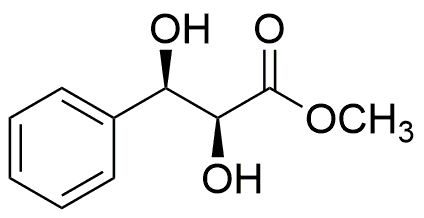Methyl (2S,3R)-(-)-2,3-dihydroxy-3-phenylpropionate is widely utilized in research focused on:
- Pharmaceutical Development: This compound serves as a key intermediate in the synthesis of various pharmaceutical agents, particularly those targeting metabolic disorders.
- Flavor and Fragrance Industry: Its unique aromatic properties make it valuable in creating flavoring agents and fragrances, enhancing the sensory experience in food and cosmetic products.
- Biochemical Research: Researchers use this compound to study enzyme activity and metabolic pathways, providing insights into biological processes and potential therapeutic targets.
- Polymer Chemistry: It can be employed in the formulation of specialty polymers, contributing to materials with improved mechanical and thermal properties.
- Cosmetic Formulations: The compound's moisturizing and skin-beneficial properties make it a popular choice in developing skincare products, offering advantages over traditional ingredients.
Informations générales
Propriétés
Sécurité et réglementation
Applications
Methyl (2S,3R)-(-)-2,3-dihydroxy-3-phenylpropionate is widely utilized in research focused on:
- Pharmaceutical Development: This compound serves as a key intermediate in the synthesis of various pharmaceutical agents, particularly those targeting metabolic disorders.
- Flavor and Fragrance Industry: Its unique aromatic properties make it valuable in creating flavoring agents and fragrances, enhancing the sensory experience in food and cosmetic products.
- Biochemical Research: Researchers use this compound to study enzyme activity and metabolic pathways, providing insights into biological processes and potential therapeutic targets.
- Polymer Chemistry: It can be employed in the formulation of specialty polymers, contributing to materials with improved mechanical and thermal properties.
- Cosmetic Formulations: The compound's moisturizing and skin-beneficial properties make it a popular choice in developing skincare products, offering advantages over traditional ingredients.
Documents
Fiches de données de sécurité (FDS)
La FDS fournit des informations de sécurité complètes sur la manipulation, le stockage et l’élimination du produit.
Spécifications du produit (PS)
Le PS fournit une description complète des propriétés du produit, notamment sa composition chimique, son état physique, sa pureté et les exigences de stockage. Il détaille également les plages de qualité acceptables et les applications prévues du produit.
Certificats d'analyse (COA)
Recherchez des certificats d'analyse (COA) en saisissant le numéro de lot du produit. Les numéros de lot et de lot se trouvent sur l'étiquette d'un produit, après les mots « Lot » ou « Lot de fabrication ».
Numéro de catalogue
Numéro de lot/série
Certificats d'origine (COO)
Ce certificat d'exploitation confirme le pays dans lequel le produit a été fabriqué, et détaille également les matériaux et composants utilisés et s'il est issu de sources naturelles, synthétiques ou autres sources spécifiques. Ce certificat peut être requis pour les douanes, le commerce et la conformité réglementaire.
Numéro de catalogue
Numéro de lot/série
Fiches de données de sécurité (FDS)
La FDS fournit des informations de sécurité complètes sur la manipulation, le stockage et l’élimination du produit.
DownloadSpécifications du produit (PS)
Le PS fournit une description complète des propriétés du produit, notamment sa composition chimique, son état physique, sa pureté et les exigences de stockage. Il détaille également les plages de qualité acceptables et les applications prévues du produit.
DownloadCertificats d'analyse (COA)
Recherchez des certificats d'analyse (COA) en saisissant le numéro de lot du produit. Les numéros de lot et de lot se trouvent sur l'étiquette d'un produit, après les mots « Lot » ou « Lot de fabrication ».
Numéro de catalogue
Numéro de lot/série
Certificats d'origine (COO)
Ce certificat d'exploitation confirme le pays dans lequel le produit a été fabriqué, et détaille également les matériaux et composants utilisés et s'il est issu de sources naturelles, synthétiques ou autres sources spécifiques. Ce certificat peut être requis pour les douanes, le commerce et la conformité réglementaire.


